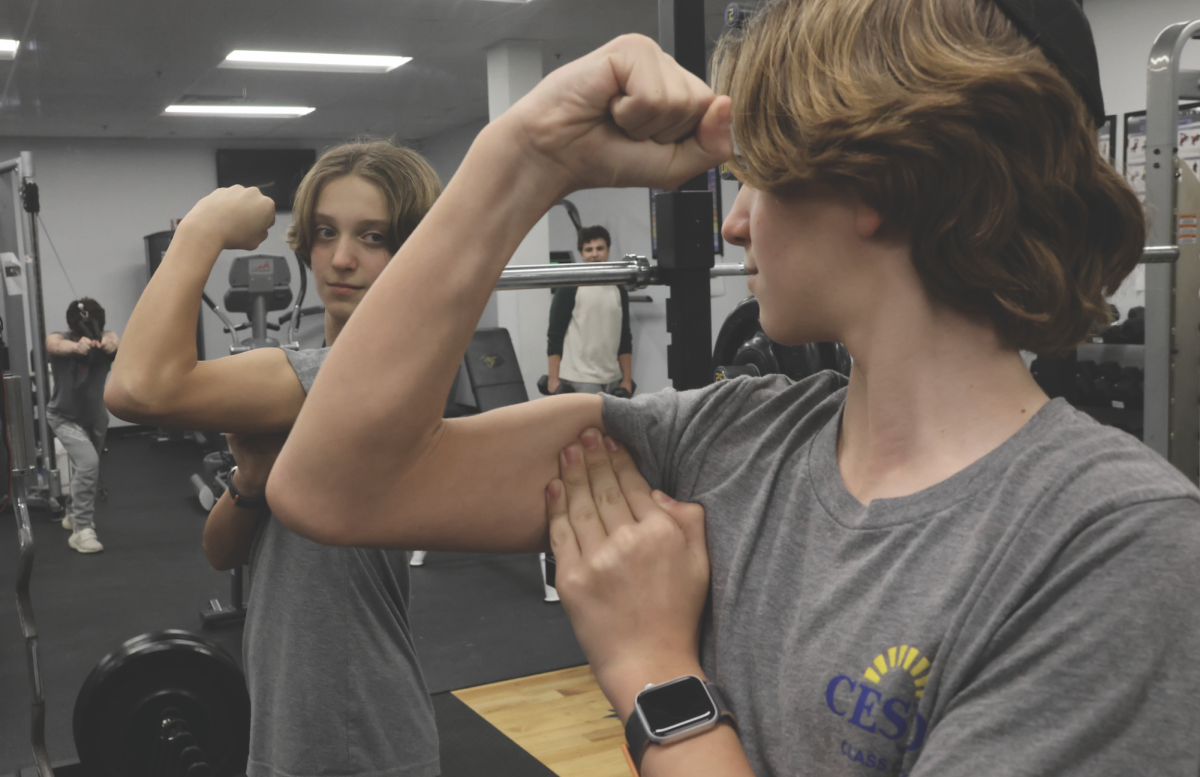Intro:
As he looks into the mirror, junior Phillip Rosen cannot help but feel disappointed in himself. After working out and committing to a fitness routine for months on end, he still feels insecure about his body and doesn’t feel satisfied with his muscular development. Though Rosen may feel alone in his struggle, the reality is that body dysmorphia and many other gym-related mental health issues are common among his gender and age demographic.
The teen mental health crisis is taking over the country right now, as one-third of the student population experienced poor mental health in 2021, according to the Centers for Disease Control. Around 30% of students experienced poor mental health and 10% of students attempted suicide(CDC). These numbers are from 2021 and continue to grow yearly, making mental health an ever more pressing issue.
Prominence of Male Mental Health:
Schools across the country, CESJDS included, provide mental health education and support services. In addition to this, according to the World Health Organization, workplaces are becoming more understanding of mental health challenges. However, according to the National Institute of Health (NIH), this education is often geared towards females as there is a much greater emphasis on it.
The underlying causes of male mental health issues are very different from those of females. Although many male mental health challenges go undiagnosed according to the Anxiety and Depression Association of America (ADAA), statistics show that females and males suffer equally from mental health. Some statistics even show greater suffering of males relating to mental health despite women’s mental health being more widely recognized. According to the CDC, 23.8 men aged 15-24 out of 100,000 committed suicide in 2021 compared to 6.1 women aged 15-24 out of 100,000. That means 390% more men age 15-24 died of suicide in 2021 than women of the same age range in 2021.
Added pressures from social media and stigma work together to create a broader mental health issue among men, as toxic masculinity is promoted on these sites (Innovation Unit). Men often struggle to talk about how they feel, significantly impacting their overall wellness. According to the CDC, 24% of women received mental health treatment compared to only 13.4% if men and double the percent of women have medication.
“As we grow up, we’re taught to keep our thoughts and feelings in,” junior Ben Polonsky said. “Instead of slowly leaking, we just let it build up and explode.”
Emotional Pressures:
Polonsky has always loved to dance, even though he was the only male in his ballet class until the age of ten. Although he loves the sport and would never quit, he has always felt particularly challenged due to the lack of men in ballet.
“The role of males in ballet is to be chivalrous, and by definition we have to be strong and confident,” Polonsky said, “Not only do we have societal norms placed on us, but those additional expectations.”
However, these societal norms aren’t specific to dance. According to PsychCentral, there is a global stigma across the world and in many cultures for men to be emotionless. According to the American Psychological Association, this stigma is why men are much less likely to get help when they are struggling. These expectations make it more difficult for men to feel comfortable reaching out, even to family and friends.
This is not only prominent in grown men, but also in teenagers and children.
“I definitely have friends who I’m close with, but I would never reach out to them for mental health stuff,” Alex said, “I feel like because of everything around me I’ve kind of been trained not to let my emotions out.”
In modern society, men are often expected to be strong, put together and self-sufficient, but these standards are unrealistic. These standards lead men to bottle up their emotions, which can in turn affect their relationships, work and overall performance (Anxiety & Depression Association of America).
Suffocating expectations like these are prevalent at Montgomery County Public Schools (MCPS), not just private schools. MCPS guidance counselor and social worker Mamata Hotha has seen many school-aged boys struggle with speaking up about their mental health.
“The problem is that boys can come across very defiant or very cheeky,” Hotha said. “So it’s like they’re masking what’s going on and I think to the outside observer they may not know that they’re really actually struggling and they’re just kind of masking it in some way.”
According to Polonsky, men aren’t used to having a space to discuss emotions, and as a result their struggles are worsened due to the lack of help This feeds into toxic masculinity, which also plays a large role in negative stigma surrounding men’s mental health.
Toxic masculinity is an attitude or social guidelines stereotypically expected of men. This is engraved in boys from a young age, as the adults around them – subconsciously or consciously – often teach them to be strong, tough and not show weakness. Although these values can all be positives, forcing them on young children often comes with negative consequences (The Children’s Society).
“Men aren’t used to talking about emotions and they bottle them in,” Polonsky said. “If you really think about it, when’s the last time you saw a guy cry?”
Body dysmorphia:
Body dysmorphia is one well known mental health challenge that is usually attributed to women, as runway models often put pressure on women to fit societal expectations. However, according to the National Eating Disorders Collaboration (NEDC), males and females suffer from body dysmorphia equally.
Many men also suffer from a different type of dysmorphia, known as muscle dysmorphia. This disorder is almost exclusive among men and causes men to believe they are too small and not muscular enough, according to NIH. It also says that this disorder often appears among men who are overly muscular and can cause them to abuse anabolic steroids and other drugs to artificially enhance their appearance according to the Cleveland Clinic.
Many teenagers, boys and girls alike, struggle with body dysmorphia because of their changing bodies. Because teenage years are a time of development, every teenager’s body is different, leading to frequent comparisons and insecurities (Anxiety Institute).
“When I was struggling the most I just didn’t like anything I saw in the mirror,” Alex said, “I felt like I was way too skinny.”
Muscle Dysmorphia and mens body dysmorphia in general is much less well known than the typical body dysmorphia we see on the internet; even in the professional field. This is partially because it is much more prominent among male than females and it is not talked about enough (NIH).
“I feel like girls kind of get more attention for this stuff and like people always talk about it but they don’t really do that with guys” Alex said.
Social media:
Additionally, the rise of gym and men’s health content on social media has played a role in many teenage boys’ insecurities.
“I think there is a positive and negative side of seeing the gym on social media,” junior Adam Bachrach said. “The positive is that it can get a lot of people to go to the gym but the negative is that a lot of people compare themselves to like these like super jacked Instagram guys.”
Like Bachrach said, gym content can have positive and negative effects. For some it works as a positive motivator, while for others, it encourages unhealthy behaviors such as taking performance enhancers.
Many prominent influencers use steroids to promote a naturally unattainable figure and, according to Rosen, this can make respecting them very difficult.
“It’s hard to look up to people who use steroids because it is not naturally attainable,” Rosen said.
Alex was first motivated to go to the gym through social media, but that positive reinforcement soon turned into a negative influence.
“The deeper in I got to Instagram the more extreme the stuff I saw was … stuff that probably wasn’t healthy,” Alex said.
Gym culture:
Going to the gym is seen as a rite of passage for many teenage boys. They often start going with the goal of increasing their overall fitness and improving their body image. However, there can be a certain culture that has developed within the gym, putting a lot of pressure on gym goers.
Despite the pressure of gym culture, most mental health problems come from a more internal sense of pressure. Many teenagers go to the gym to get their bodies to look a certain way. Whether this be bulkier or skinnier, both goals can lead to body dysmorphia.
Body dysmorphia can cause people to get stuck in what is known as a bulking and cutting cycle, which is when someone “bulks” by intaking high amounts of food in order to gain muscle and fat. Then that person turns around later and “cuts” by intaking low amounts of food in order to burn off that muscle and fat they gained from bulking.
“Dieting is a restriction, it’s a nutrient deficiency, which can cause a negative effect on really every single process in the body,” Founder of ReNutrition and licensed nutritionist Rachel Engelhartsaid.
The difficulty of this type of eating is that it is really hard to stop eating this way, and those with body dysmorphia come to rely on it.
“If you are 170, you say, ‘I want to get to 190.’ Then you hit 190, and you want to go to 200, and when you are 200, you don’t like how you look at that weight,” Rosen said. “Then you cut and say, ‘I am gonna go to 160. I don’t like how I look at 160. I am gonna go to 150.’ So if you don’t stay in line with your goals, you can really easily get an eating disorder.”
Many sports, such as wrestling, gymnastics and swimming, put a lot of emphasis on a specific body weight or shape. While sports like these are not gateways for eating disorders, it’s important to be conscious about one’s obsession with keeping that specific body weight or shape.
“If you’re wrestling and making sure that you’re maintaining a weight by eating a certain number of calories or set meals a day, that’s not an eating disorder. If you begin obsessing over the number and restricting foods so that you hit the bottom of a class or shave off one more pound to change classes or whatever it may be, you could be treading that line carefully,” guidance counselor Marnie Lang said.
While cutting and bulking can help people look more muscular, it can be extremely dangerous, and it is essential to keep physical health in mind according to middle school Tanakh teacher and personal trainer Michael Rubin.
“I know at the end of the day, it probably doesn’t affect me that much,” Jacob said. “If I eat pizza now, I’m not gonna be slower at my race in two weeks probably. But it is kind of just a mindset thing. It keeps me focused on making healthy decisions.
How we can help:
With all of this in mind, it is important to find ways to overcome the overwhelming culture and stigma. In terms of conquering the insecurities and body dysmorphia that come from gym culture, one of the best things someone can do is research.
“Actually go out there and talk to competent experts who can give you the information you need to actually achieve the goals you are looking for in a responsible way,” Rubin said.
It is also important to understand that success is very relative and is determined by how one views themselves.
“It matters how much you compare yourself,” Jacob said. “I could compare myself to the elite runners who are winning Olympic gold medals and I would feel like [a] failure, or I could compare myself to the middle schoolers and I would feel really good about myself.”
For those who have mental health struggles or who know someone who is, there are various resources available, both in-person and online. One resource is the Montgomery County Crisis Center’s Mobile Crisis Team (MCT), which provides free emergency crisis evaluations for individuals experiencing a mental health crisis 24 hours a day.
It is also vital that the importance of seeking treatment be emphasized for both males and females as only 19% of people between 12-17 are treated for their mental health issues, according to Sandstone Care. Regardless of gender, teenagers across the world are affected by mental health struggles and it is our responsibility to create an equally supportive and helpful community for both males and females.
““All students, male, female or gender neutral, hold specific images of what they want to project, and while they may be different, a counselor would approach their concerns, their sadness, their depressions the same way. Our goal is to work with each person as an individual,” Dean of Students Roslyn Landy said.












